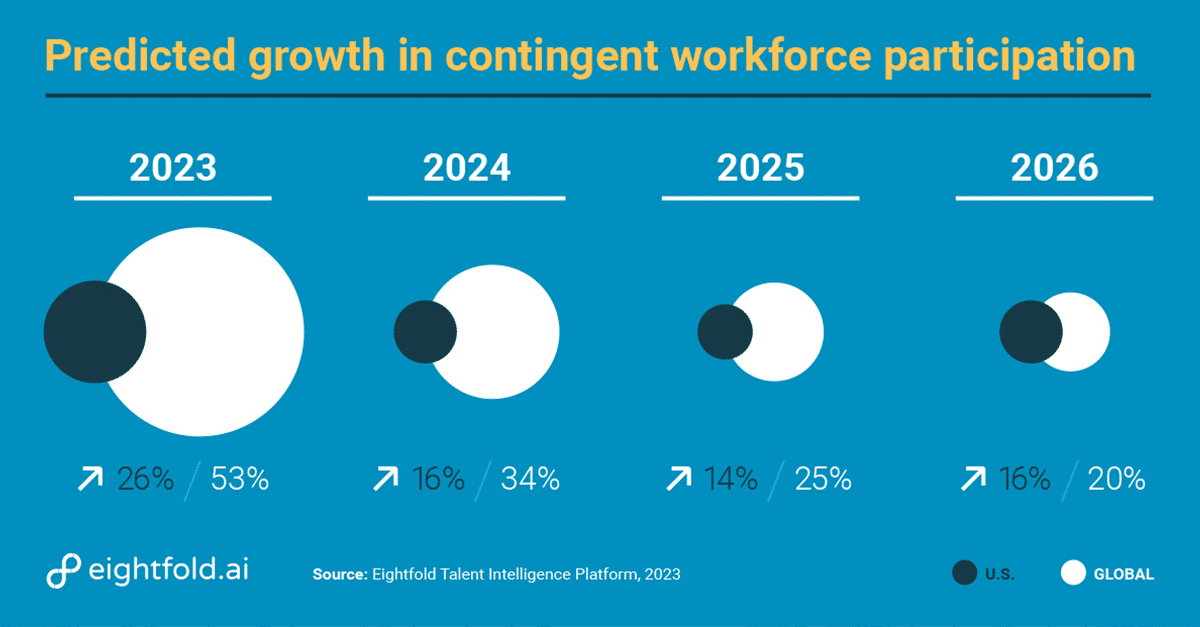- Eightfold AI insights predict a significant increase in global contingent workforce participation in 2023, positively impacting DEI goals
- Contingent work arrangements will bring relief to the tight labor market
- New solutions are needed to develop an elastic talent strategy to include contingent workers
Contingent workers — freelancers, consultants, contractors, no matter what you call them — are going to become an even more essential part of everyone’s workforces around the world. This year alone, the contingent workforce is projected to grow by 53 percent worldwide, according to our latest talent insights.
The news that this part of the workforce is growing should come as no surprise. According to McKinsey, 36 percent of the workforce self-identifies as independent workers. But several factors — economic uncertainty, layoffs, and the move toward aligning skills to work — contribute to this workforce’s growth in hyperdrive.

Powered by the largest global talent data set, our Chief Economist Sania Khan took a closer look at the contingent workforce data. While this vital part of every workforce is set to grow, she said that this expansion will also positively impact the global economy.
How? While some industries are facing serious talent shortages, others are implementing layoffs, hiring freezes, and the like. In addition, many organizations lack the tools and resources to build the right workforce skills to help them reach their business goals.
Leaning on the contingent workforce is a solution for both sides of the spectrum. There are many upsides to investing in your contingent workforce, including closing skill gaps without adding full-time workers. In addition, Khan said an uptick in contingent hiring could pave the way for underrepresented groups to enter the workforce, making organizations more diverse. In today’s economic environment, this is particularly critical for not deterring DEI progress.
Read on for more insights from Khan on why building an elastic talent strategy is more important than ever to make the most of the rise of the contingent worker.
Tell us about the rise of contingent work over the last few decades — and projections for the coming decade. What does Eightfold AI data tell us about this trend?
Sania Khan: As it turns out, workers crave autonomy and flexibility, possibly even more so than the stability of a full-time job.
We saw the first signs of this change after the 2008 recession when participating in the gig economy became very popular. Employers also value the flexible, cost-effective, and viable talent pool they can tap into.
Currently, many industries face unprecedented labor shortages, creating a massive opportunity for organizations to change how they hire and retain talent. The ability to bring in specialized skills on an as-needed basis has great value, especially for smaller organizations that need the expertise but might not want to support a full-time salary.
Some talent teams are shifting to a more elastic workforce, which includes more contingent workers, whether due to economic uncertainty or the need for on-demand talent. (Ed note: Watch the following video to learn why Dolby is hyper-focused on its elastic workforce.)
Our proprietary Eightfold data analysis estimates that the contingent workforce participation is projected to significantly increase over the next few years, with a 53 percent increase in 2023, despite a decline in 2020 and an average growth of only 6 percent in the past few years.
Complete projections are as follows:
- 2023:
- Global contingent workforce participation: 53% increase
- U.S. contingent workforce participation: 26% increase
- 2024:
- Global contingent workforce participation: 34% increase
- U.S. contingent workforce participation: 16% increase
- 2025:
- Global contingent workforce participation: 25% increase
- U.S. contingent workforce participation: 14% increase
- 2026:
- Global contingent workforce participation: 20% increase
- U.S. contingent workforce participation: 16% increase

What are the fastest-growing types of contingent workers? What are the most in-demand specialized skill sets?
S.K: Contingent worker skills are specialized and can vary widely. According to Eightfold research, the top 10 titles held by contract workers globally include:
- Software/web developers
- Recruiters
- Project managers
- Business analysis
- Marketing-related occupations
- Technical writers
- Scrum master
- Graphic designer
- Maintenance-related occupations
- Management specialists
Why are people gravitating toward freelance work? What bigger-picture trends have contributed to this popularization? How has the perception of gig work changed over time?
S.K.: Our Eightfold analyses found that contingent workers have varied backgrounds and span across all ages, education levels, and incomes. In 2022, our Eightfold research found that compared to previous years, a greater proportion of contingent workers have more than 10 years of experience at mid-level or executive-level positions and have graduate degrees with high-paying majors.
This could result from more workers leaving the stable confines of a “full-time job” to work as contingent workers, which reflects the desire for change, flexibility, and autonomy.
According to a study, freelancers felt they were leading richer lives than their corporate counterparts. Despite the challenges of independent work, these workers endure those drawbacks for the upside of flexibility and setting their own schedules and rates.
How does employee experience and burnout impact the rise in contingent work? Tell us about current retention rates.
S.K.: Retention has been a major issue for talent leaders. In November 2021, the U.S. reached an all-time peak in voluntary turnover, and although it’s been declining recently, it still hasn’t reached pre-pandemic levels. So it’s possible that a correlation exists between high turnover and increased contingent worker hiring to fill skill gaps without hiring full-time staff.

Do economic phenomena like recessions, labor shortages, or inflation contribute to the rise in contingent work?
S.K.: Yes, and we expect a rise in the next few years as these economic issues persist. With economic climate or funding concerns, risk-averse employers can hire contingent workers, enabling them to observe employee performance and skills without long-term commitments.
The current labor shortages aren’t abating, making filling open roles increasingly difficult. According to SHRM, 83 percent of U.S. businesses are struggling to find workers with the right skills.
If companies can’t find the skills they need within their workforces or labor shortages have put those skills in short supply, contingent labor may be the answer. Employers can fill strategic roles without increasing permanent headcount and staying within constrained budgets.
How are contingent workers distributed across generations and experience levels?
S.K.: In our analysis, we found that the experience level of contingent workers in 2022 is evenly distributed among generations, with half making up those with under 10 years of experience and the other half roughly split between those with 10 to 15, 15 to 20, and more than 20 years of experience.
At the start of the COVID-19 pandemic, the proportion of contingent workers with less experience fell, and there were more contingent workers with five to 10 years of experience. However, in 2021, the distribution of contingent workers in terms of experience reversed back to the 2019 level.
How is this trend impacting DEI efforts?
S.K.: We found that the proportion of women in the contingent workforce fell initially in 2020 and even more in 2021, most likely due to childcare and elder care responsibilities during the pandemic. According to our analysis, the proportion of women in the contingent workforce increased to 46 percent in 2022, almost reaching 2019 levels.
Post-pandemic, there was also a drastic increase of Asians in the contingent workforce, particularly in 2021. Simultaneously, there was a drastic decrease in white workers in the contingent worker pool in 2021. However, those trends reversed back to pre-pandemic levels in 2022.
In addition, contingent work is a good option for those who prefer flexibility in how, when, and where they work — and it’s a great way to re-enter the workforce. Numerous studies show that taking time off from a career can create a hurdle for most employees, particularly women. Contingent work allows these workers to reacquaint themselves with work and learn new skills — or remain in the workforce with additional flexibility.

Did anything surprise you from your research on contingent work?
S.K.: Employers are hiring contingent workers for even more experienced positions, an outcome of a tight labor market.
Our analyses showed that in 2022, there was a drastic and unprecedented change in the distribution of experience levels in the contingent workforce. In 2021, around 48 percent of contingent workers had less than five years of experience, and 30 percent had more than 10 years of experience. In 2022, the proportion of workers with less than five years of experience fell by half, and the proportion of workers having more than 10 years of experience increased by two-thirds.
This also suggests that in 2023, contingent workers will be hired even for more experienced positions because of uncertain economic conditions. As a result, employers can meet their needs with a more elastic talent strategy.
Describe how the rise of contingent workers impacts organizations.
S.K.: Organizations can tap into this valuable workforce to meet their unmet and unique needs. For instance, if an organization has an influx of work or a complex project, contingent workers may be able to fill these needs on an on-demand hiring basis. This elastic approach to talent greatly benefits organizations that need to do more with less in a tight labor market.
Hiring contract workers provides employers with greater workforce management flexibility. For example, with contingent work arrangements, organizations can easily change the size of their workforce in response to rapidly changing labor market movements without the associated costs of layoffs, both financially and in the form of employee morale and productivity.
Organizations can balance building talent strategies with contingent workers based on their needs and market conditions and reassess as needed. Organizations with a lower-cost talent pool can also further pinpoint which skills correspond to innovation, effectiveness, or particular goals.
Is your organization rethinking how it hires and manages contingent workers? Learn why organizations choose Eightfold Talent Flex to get a 360-degree view of their elastic workforces.

Sania Khan is the Chief Economist at Eightfold AI and the author of Think Like an Economist. Read the latest blog from Sania to learn about the in-demand tech skills every workforce needs.



